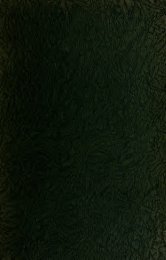Memoirs on the coleoptera
Memoirs on the coleoptera
Memoirs on the coleoptera
You also want an ePaper? Increase the reach of your titles
YUMPU automatically turns print PDFs into web optimized ePapers that Google loves.
336<br />
MEMOIRS ON THE COLEOPTERA<br />
distinguish <strong>the</strong> two very readily. The type may be outlined as<br />
follows :<br />
*Zalophia spissicornis n. sp. Ra<strong>the</strong>r stout, moderately c<strong>on</strong>vex, deep<br />
black throughout, excepting <strong>the</strong> entire inner costa and <strong>the</strong> narrower outer<br />
costa to a little before <strong>the</strong> middle, scarcely at all shining, <strong>the</strong> pubescence<br />
above everywhere close, l<strong>on</strong>g <strong>on</strong> <strong>the</strong> prothorax above and beneath, very<br />
short <strong>on</strong> <strong>the</strong> elytra, deep black throughout; <strong>on</strong> <strong>the</strong> under surface of <strong>the</strong><br />
hind body it is sparse, <strong>the</strong> latter polished, <strong>the</strong> punctures becoming fine<br />
and dense <strong>on</strong>ly at <strong>the</strong> extreme sides; head very densely, finely sculptured,<br />
with a fine tumescent smooth line at base <strong>on</strong>ly; antennae (cf) about a<br />
fourth l<strong>on</strong>ger than <strong>the</strong> body, feebly tapering and flattened distally, <strong>the</strong><br />
third joint nearly a fourth l<strong>on</strong>ger than <strong>the</strong> fourth, which is a little shorter<br />
than <strong>the</strong> equal five to nine, tenth very little shorter but ra<strong>the</strong>r abruptly<br />
narrower, <strong>the</strong> eleventh but little l<strong>on</strong>ger, <strong>the</strong> appendage short and scarcely<br />
traceable; prothorax two-fifths wider than l<strong>on</strong>g, <strong>the</strong> truncate apex but<br />
little narrower than <strong>the</strong> base, minutely, deeply c<strong>on</strong>stricted at <strong>the</strong> margin;<br />
sides broadly subangulate to <strong>the</strong> tubercle, <strong>the</strong> surface ra<strong>the</strong>r finely, ex-<br />
fine and tumescent but not im-<br />
tremely densely punctate, with a very<br />
punctate median line in more than apical half, circularly c<strong>on</strong>cave at<br />
<strong>the</strong> middle basally; scutellum very acute, much l<strong>on</strong>ger than wide, punctate,<br />
but not densely pubescent; elytra cuneiform, at base much wider<br />
than <strong>the</strong> prothorax, two and <strong>on</strong>e-half times as l<strong>on</strong>g as wide, ra<strong>the</strong>r<br />
finely, very densely punctate, <strong>the</strong> inner ridge notably large, smooth and<br />
str<strong>on</strong>g; fifth ventral sinuate medially at apex. Length 14.5 mm.;<br />
width 4.2 mm. Ecuador (Babahoyo at foot of Andes).<br />
Recognizable by <strong>the</strong> dull and intensely black integuments,<br />
bristling black pubescence, very large and entire inner elytral ridge<br />
and o<strong>the</strong>r characters as related above.<br />
Crossidius Lee.<br />
This genus is a very large <strong>on</strong>e and <strong>the</strong> species are generally<br />
well differentiated. Numerous forms still unpublished exist in all<br />
<strong>the</strong> larger collecti<strong>on</strong>s; <strong>the</strong> following comprise about all <strong>the</strong> n<strong>on</strong>de-<br />
scripts that are before me at present:<br />
Crossidius plagiatus n. sp. General form and colorati<strong>on</strong> as in punctatus<br />
but a little larger and stouter, <strong>the</strong> two fine impunctate lines disappearing<br />
apically <strong>on</strong> each elytr<strong>on</strong> more evident; antennae (cf) more<br />
distinctly l<strong>on</strong>ger than <strong>the</strong> body, o<strong>the</strong>rwise nearly similar; prothorax much<br />
less transverse and not so densely or c<strong>on</strong>spicuously pubescent; elytra<br />
nearly similar in form and sculpture but with <strong>the</strong> black sutural marking<br />
different, not el<strong>on</strong>gate-fusiform and narrowed before and behind as in<br />
punctatus (cf ), but parallel and straight at <strong>the</strong> sides, obtusely, angularly<br />
produced al<strong>on</strong>g <strong>the</strong> suture anteriorly, rounded behind, <strong>the</strong> suture narrowly<br />
black to <strong>the</strong> apices; abdomen much less densely punctate and<br />
pubescent, <strong>the</strong> segments black, finely pale at <strong>the</strong>ir apices, <strong>the</strong> last two



